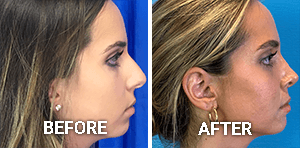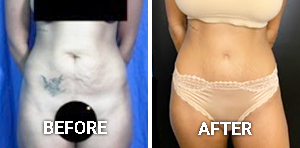Fat Transfer
Conveniently located to serve the areas of Beverly Hills and Greater Los Angeles

A fat transfer (fat grafting or fat injection) is a procedure that improves the volume of your skin by transferring excess fat from one area of the body and injecting it into another. With a fat transfer, we can improve the appearance of the outer thighs, hands, face, breasts, or buttocks. Fat transfers work well in treating sunken cheeks, facial lines, acne scars, and the other effects of aging. Unlike implants that have a risk of the body rejecting them, a fat transfer improves your figure with your body’s natural fat for natural-looking results.
Michael Omidi, M.D., F.A.C.S., is a board-certified plastic surgeon with more than 15 years of experience helping patients enhance their appearance and achieve beautiful results. If you have hollow cheeks and sagging skin resulting in jowls, a fat transfer can improve your appearance with lasting results.
Contact our Beverly Hills office or call (310) 281-0155 to learn how a fat transfer can improve your appearance.
Contents
About Fat Transfer
Unlike dermal fillers that use synthetics, fat transfers replenish volume without an overfilled or unnatural appearance. With a fat transfer, you can enjoy results that look and feel natural while lasting longer. Although temporary fillers can dissolve, injectables provide longer-lasting volume. In 2023, specialists performed more than 29,300 buttock augmentation procedures with fat grafting and more than 34,000 cosmetic facial fat grafting procedures to help patients enhance their appearance. (1)
Liposuction
To harvest excess fat, Dr. Omidi will utilize liposuction, a treatment that removes the pockets of fat with a small cannula and tumescent fluid to minimize downtime. Tumescent fluid combines lidocaine, saline, and epinephrine, causing the fat cells to swell for easier removal while also reducing a patient’s discomfort by numbing tissue internally. With a small incision, Dr. Omidi can access the fatty tissue, remove it, and then purify it in a centrifuge to remove impurities. With liposuction, he can sculpt your figure while also removing excess fat to use in your transfer.
Facial Fat Transfer vs Facelift
Unlike a facelift that removes excess skin with incisions, a fat transfer can reduce signs of aging and address age-related volume loss with minimal downtime for a smoother appearance. Although a fat transfer cannot remove excess skin or tighten the skin, it can diminish fine lines, wrinkles, and the appearance of jowls for a more youthful-looking complexion.
Benefits
There are several benefits to a fat transfer, including:
- Balanced proportions: Dr. Omidi can sculpt your figure for a curvier appearance and restore lost volume to multiple body areas for a more balanced appearance.
- Minimal downtime: Dr. Omidi can use a specialized technique to minimize downtime, ensuring a smoother recovery and allowing you to return to your daily routine shortly after.
- Small incisions: With a small incision, he can remove excess fat to minimize scarring. Incisions are typically less than 1.5 centimeters and are placed where they can easily be hidden.
- Customizable treatment: Depending on your needs, Dr. Omidi can treat multiple areas of the body in one appointment to minimize downtime.
- Natural-looking volume: Using your own fat can provide natural-looking volume to help you achieve beautiful, lasting results.
Candidates
Suitable candidates for fat transfer are individuals who would like to sculpt their bodies or improve their complexions for long-lasting, natural-looking results.
If you are a healthy nonsmoker who wants plumper skin and wants to restore volume with a natural-looking appearance and lasting results, fat transfer can help you achieve a more youthful appearance. Facial fat grafting is ideal for candidates who wish to balance their facial proportions, diminish wrinkles, and address volume loss in the face. (2) Dr. Omidi can also restore volume to the lips for a plumper, smoother appearance. (3) Patients looking to balance their proportions or improve their facial harmony after reconstructive surgery may find a fat transfer to be a helpful procedure.
Personal Consultation
During your consultation, Dr. Omidi will examine your skin. Please come prepared to discuss your aesthetic goals, medications, and lifestyle to help us create an effective treatment plan. It is important that you have realistic expectations for the treatment, and he can address any additional goals you have.
We can discuss whether you would like to enhance the appearance of more than one area with a fat transfer. Dr. Omidi also offers other body sculpting procedures to help you achieve your aesthetic goals.
To learn more about our additional treatments, see the blog!
Preparation
To prepare for your treatment, you will need to:
- Stop taking blood thinners
- Avoid sun exposure
- Stop drinking alcohol for 24 hours before and after your procedure
- Arrange for someone you trust to drive you home
- Plan your meals ahead of time
- Pick up any prescriptions you need for your recovery
- Create a comfortable place in your home to recover
Procedure

During the procedure, your anesthesiologist will place you under anesthesia, and our team will cleanse your skin. Dr. Omidi will remove excess fat from one area of the body with liposuction and purify it in a centrifuge to extract the purest fat cells for the transfer. After performing liposuction, he will carefully re-inject fat into the areas where you would like to add volume. He will repeat this process until he addresses the concerns you discussed during your consultation.
After completing the fat transfer, he will place a bandage over the area where he performed liposuction. Depending on your aesthetic goals, he may perform multiple fat transfers during one appointment. Fat transfers generally take no more than 30 minutes to an hour.
Recovery
The recovery from a fat transfer is minimal, and Dr. Omidi can provide specific instructions to help you recover depending on the type of procedure you need. You must avoid excessive sun exposure for 2-3 weeks afterward.
It is not uncommon to experience some swelling or bruising in the treatment area after the procedure. If you experience discomfort, you can use cold compresses and over-the-counter medication. Depending on the area where you receive a fat transfer, you may also need to keep your head elevated when lying down to help your body heal and relieve discomfort. Mild discomfort is usually easily controlled with medications prescribed by your surgeon.
Results
Depending on the location of the fat transfer and your treatment plan, you can enjoy lasting results after a fat transfer. For example, a facial fat transfer can result in a smoother, plumper appearance and a more radiant complexion. A transfer to the buttocks can result in balanced proportions and a curvier appearance.
You must maintain a stable weight to maintain your results since weight changes can affect your results. The results are long-lasting, usually for many years, if you take good care of your body. Exercising regularly and eating healthy meals will be important for maintaining your appearance.
Corresponding Procedures
Facelift
A facelift can improve the appearance of facial aging and turn back the clock for a smoother, youthful look. Dr. Omidi can tighten the skin with a discreet incision for lasting results. Some patients choose to address lax skin in addition to receiving a fat transfer to rejuvenate their complexions for a smoother look.
Facial Feminization
Facial feminization is a collection of procedures that can help you transform your appearance for a smoother, more feminine look. If you are transitioning, this procedure is especially helpful for aligning your gender expression with your gender identity so that you can feel more like yourself. With our customizable procedures, Dr. Omidi can help you improve your quality of life for lasting results.
Rhinoplasty
Rhinoplasty (nose reshaping) is a procedure that reshapes the nose for a smoother look by modifying the underlying bone and cartilage. If you have a prominent nose, Dr. Omidi can help you achieve a softer, smoother, more balanced appearance with the procedure. (4)
The Cost of Fat Transfer in Beverly Hills
The cost of a fat transfer will depend on the size of the treatment area and the amount of fat you would like to transfer. Depending on your skin type, Dr. Omidi can recommend additional treatments to help you maintain your results and achieve your goals. He can also provide an all-inclusive quote and discuss financing options to help make your treatment more accessible.
Contact our Beverly Hills office or call (310) 281-0155 to learn how Dr. Omidi can enhance your appearance for long-lasting results with a simple treatment that has helped thousands of patients improve their figures.
FAQ
Will I need multiple fat transfers?
You should be able to achieve results with just one fat transfer.
Can I have a fat transfer if I am planning to become pregnant?
We recommend that you wait to have a fat transfer if you are planning to become pregnant because pregnancy can affect your results.
Will I have any scarring after a fat transfer?
We make a discreet scar along your natural curves to harvest the excess fat. During your consultation, we can answer any questions you have.
How will I know if a fat transfer fits me well?
If you have excess fat that you would like to use to improve your appearance and are a nonsmoker in good overall health, you are likely a good candidate for a fat transfer.
References
- American Society of Plastic Surgeons ® Endorsed Partner. https://www.plasticsurgery.org/documents/news/statistics/2023/plastic-surgery-statistics-report-2023.pdf
- Shauly O, Gould DJ, Ghavami A. Fat Grafting: Basic Science, Techniques, and Patient Management. Plastic and Reconstructive Surgery – Global Open. 2022;10(3):e3987. doi:https://doi.org/10.1097/gox.0000000000003987
- Schultz KP, Raghuram A, Davis MJ, Abu-Ghname A, Chamata E, Rohrich RJ. Fat Grafting for Facial Rejuvenation. Seminars in Plastic Surgery. 2020;34(01):030-037. doi:https://doi.org/10.1055/s-0039-3402767
- Hohman MH, Teixeira J. Transgender Surgery of the Head and Neck. PubMed. Published 2024. https://pubmed.ncbi.nlm.nih.gov/33760488/





